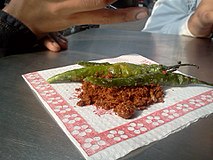Garlic chutney, also referred to as lahsun chutney, lahsun ki chutney, lehsun chutney and bellulli chutney, is a chutney, originating from the Indian subcontinent, made from fresh garlic, dry or fresh coconut, groundnuts and green or red chili peppers.[1][2][3][4] Cumin and tamarind are also sometimes used as ingredients.[3][5][6][7] It is prepared in both wet and dried forms.[8] The wet variety is made with fresh grated coconut and is typically served immediately after preparation.
Dry variety
The dry variety is a commercial product purveyed in packets and jars.[9] Homemade dried garlic chutney can be stored in bottles and will last up to four weeks. When refrigerated, it can be kept for up to six months.[8] It is eaten either dry or mixed with yogurt,[3] curd, buttermilk or vegetable oil. It is sometimes prepared in a powdered form.
-
Dry garlic chutney prepared with red chili pepper
Uses
Garlic chutney is used for cooking in many Indian (especially Maharashtra,[3][10] Gujarat, Punjab, Rajasthan[11] and northern Karnataka[12]) and Pakistani homes.[4] It is often eaten with fresh, hot bhakri (a flat, unleavened roti made from flour of grains such as jowar (sorghum), bajra (pearl millet), nachni (finger millet), etc.).[3] Garlic chutney is sometimes served as an accompaniment to chaats and khandvi.[10][13][14]
See also
References
- ^ Bharadwaj, M. (2005). The Indian Spice Kitchen: Essential Ingredients and Over 200 Authentic Recipes. Hippocrene Books, Incorporated. p. 113. ISBN 978-0-7818-1143-9. Retrieved 26 October 2017.
- ^ The Gazetteer of Bombay Presidency. The Gazetteer of Bombay Presidency. Printed at the Government Photozinco Press. 1961. p. 237. Retrieved 26 October 2017.
- ^ a b c d e Koranne-Khandekar, Saee (23 June 2017). "A case for chutney". Live Mint. Retrieved 26 October 2017.
- ^ a b Thaker, A.; Barton, A. (2012). Multicultural Handbook of Food, Nutrition and Dietetics. Wiley. p. 44. ISBN 978-1-4051-7358-2. Retrieved 26 October 2017.
- ^ Kapoor, S. Pickles ,Chutneys 'N' More. Popular Prakashan Pvt. Limited. p. 60. ISBN 978-81-7991-555-4. Retrieved 26 October 2017.
- ^ Singh, V. (2017). Cinnamon Kitchen: The Cookbook. Bloomsbury Publishing. p. 236. ISBN 978-1-4729-3493-2. Retrieved 26 October 2017.
- ^ Parthasarathy, V.A.; Chempakam, B.; Zachariah, T.J. (2008). Chemistry of Spices. CABI. p. 372. ISBN 978-1-84593-420-0. Retrieved 26 October 2017.
- ^ a b Gopal, Sena Desai (19 June 2017). "Recipe for Coconut-garlic Chutney". The Boston Globe. Archived from the original on 27 October 2017. Retrieved 26 October 2017.
- ^ Bladholm, L. (2016). The Indian Grocery Store Demystified: A Food Lover's Guide to All the Best Ingredients in the Traditional Foods of India, Pakistan and Bangladesh. St. Martin's Press. p. 21. ISBN 978-1-250-12079-3. Retrieved 26 October 2017.
- ^ a b Dalal, T. (2000). Chaat Cookbook. Sanjay & Company. p. 106. ISBN 978-81-86469-62-0. Retrieved 26 October 2017.
- ^ DK Eyewitness Travel Guide India. Eyewitness Travel Guides. DK Publishing. 2017. p. 352. ISBN 978-1-4654-7253-3. Retrieved 26 October 2017.
- ^ Iyer, R.; Thampan, P.K. (1991). Coconut Recipes Around the World. Central Plantation Crops Research Institute. p. 159. ISBN 978-81-7296-028-5. Retrieved 26 October 2017.
- ^ Vohra, A.R. (2012). New Modern Cookery Book. V&S Publishers. p. 150. ISBN 978-93-5057-278-8. Retrieved 26 October 2017.
- ^ Laveesh, B. (2009). Indian States at a Glance 2008-09: Performance, Facts and Figures - Gujarat. Pearson Education. p. 36. ISBN 978-81-317-2342-5. Retrieved 26 October 2017.
External links
- Garlic chutney. Vahrehvah.com.
- Dry Garlic Chutney Recipe. Foodviva.com.





Recent Comments